Sof History from Mat Sgan – Torah and Taro & Honey and Poi
Torah and Taro

Praise for Torah and Taro
February 10, 2021
Professor Edwin Yamauchi (B.A. UHM; M.A. and Ph.D. Brandeis University) Professor of Emeritus of History at Miami University of Ohio writes:
“I received and read Torah and Taro: Jewish Contributions to Hawaii. I found it informative and fascinating. Robert Littman (p.140) took my place at UH-Mānoa in 1968 when I was on leave at Rutgers University. Aloha.”
Bennett Hymer, President of Mutual Publishing of Hawaiʻi, writes:
“Torah and Taro is a compelling narrative of how Jews have contributed to Hawaiʻi in all aspects of life: business, culture, and the arts. Set against a background of Hawaiian history, the book serves as a good introduction to Hawaiʻi. Mat shows how contributions were made by the well-known and by the everyday person as they carried out their occupation, business, or profession… The reader comes away amazed at what has been accomplished by a relatively small population.”
Torah and Taro
January 12, 2021
A Book Review by Sid Goldstein
 Mat Sgan’s third book, Torah and Taro, is an informative history of the Jewish contributions to the Hawaiian Islands. The book examines the impact that the small Jewish population has had on the history, social development, and culture of Hawaiʻi as it transformed from a monarchy to a US possession to a territory and finally to a state in the United States. Sgan repeatedly points out that the population of Jews in Hawaiʻi has hovered around the 1% mark. Yet the contribution of this 1 percent of the population has outsized the numbers disproportionately. From the time of Kamehameha I, the man who unified the Hawaiian Islands into a single kingdom, Jews have played a significant role in the growth and development of the islands.
Mat Sgan’s third book, Torah and Taro, is an informative history of the Jewish contributions to the Hawaiian Islands. The book examines the impact that the small Jewish population has had on the history, social development, and culture of Hawaiʻi as it transformed from a monarchy to a US possession to a territory and finally to a state in the United States. Sgan repeatedly points out that the population of Jews in Hawaiʻi has hovered around the 1% mark. Yet the contribution of this 1 percent of the population has outsized the numbers disproportionately. From the time of Kamehameha I, the man who unified the Hawaiian Islands into a single kingdom, Jews have played a significant role in the growth and development of the islands.
Mat has done some in-depth research to prepare for the writing of this book. He quotes multiple sources from other texts about Hawaiʻi as well as biographies, newspaper accounts, personal recollections, films, and other media cataloging the history of the islands. It seems that no stone was left unturned in the hunt for source material for the book. Jewish characters abound throughout the book. One notable character is Hank Greenspan. Greenspan was the publisher of the Las Vegas Sun and a noted gunrunner to the nascent state of Israel. Greenspan, it turns out, got many of his weapons from Hawaiʻi. Sgan goes to great lengths to explain how those transactions happened and how the weapons circuitously made their way from Hawaiʻi to the Middle East. Another notable character is Harry Weinberg. Even today one can’t drive around Oʻahu (or any of the larger islands) and not see multiple buildings dedicated by Harry and Jeanette Weinberg. Yet Sgan shows us the ruthless businessman who made a mark on Hawaiʻi by squeezing out competitors and dominating his trade. Later in life we see the philanthropist whose name appears on all those buildings. Sgan’s balanced portrait of Weinberg is a highlight of this book.
Finally, there is the tribute that Mat pays to so many members of Sof Ma’arav for their contributions to the cultural, economic, and educational life of Hawaiʻi. I will not try to list the members of Sof that Mat names. But let me say that we as a community can be proud of how this membership has so positively affected life in the islands. Mat deserves both an aloha and a shalom for so beautifully pointing this out. Torah and Taro is a nicely written, well researched, and positively crafted book. I highly recommend it for anyone interested in a history of Hawaiʻi and how its Jewish citizens helped to shape it to become the place we so love today.
Torah and Taro Press Release
November 29, 2020
Mathew R. Sgan announces the release of Torah and Taro: Jewish Contributions to Hawaiʻi
New book shows how Jews, Judaism and Israel played an important role in Hawaiian history
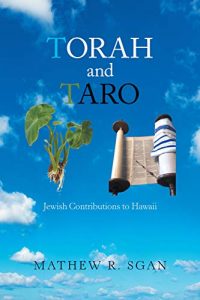 HONOLULU – Did you know that pop idol Bruno Mars from Honolulu had a Jewish Ukrainian grandmother to whom he was very close? In Torah and Taro: Jewish Contributions to Hawaiʻi, author Mathew R. Sgan highlights many important and sometimes unrecognized roles that Jews, Judaism, and Israel have played in every stage of Hawaiian history from its first unified Kingdom under Kamehameha I to its present day. Through Torah and Taro readers will learn about Jews in the Hawaiian Islands and how they related to the Indigenous people as well as to other immigrants. Although they make up less than one percent of the population, people of Jewish heritage have made a significant difference to Hawaiʻi.
HONOLULU – Did you know that pop idol Bruno Mars from Honolulu had a Jewish Ukrainian grandmother to whom he was very close? In Torah and Taro: Jewish Contributions to Hawaiʻi, author Mathew R. Sgan highlights many important and sometimes unrecognized roles that Jews, Judaism, and Israel have played in every stage of Hawaiian history from its first unified Kingdom under Kamehameha I to its present day. Through Torah and Taro readers will learn about Jews in the Hawaiian Islands and how they related to the Indigenous people as well as to other immigrants. Although they make up less than one percent of the population, people of Jewish heritage have made a significant difference to Hawaiʻi.
Sgan investigates matters which researchers have tangled with for many years and raises new ones. Who was the ‘Jew Cook’ who accompanied Kamehameha I aboard the American ship, Neptune, in a Hawaiian port in 1798? What was the relationship to Communism of labor leader Jack Hall and his Jewish advisors who broke Hawaiʻi away from the Big Five corporate oligarchy? Was Catholic architect Alfred Preis influenced by his Jewish heritage in designing the USS Arizona Memorial at Pearl Harbor?
In many ways this book is a love letter to Hawaiʻi. As a longtime visitor and 20-year Hawaiʻi resident, the author’s keen interest in the involvement and growth of the Jewish community in the islands spurred him to research and write Torah and Taro. He describes many historical issues and events in which Jews played helpful roles by assisting Hawaiʻi’s journey along what it determined was its best political, cultural, and social path.
Torah and Taro: Jewish Contributions to Hawaii By Mathew R. Sgan
Hardcover | 6 x 9in | 224 pages | ISBN 9781664132542 $ 31.99
Softcover | 6 x 9in | 224 pages | ISBN 9781664132535 $ 17.99
E-Book | 224 pages | ISBN 9781664132528 Available at Xlibris.com $ 5.99
Hardcover and Softcover books available at Amazon, Barnes & Noble, and Xlibris Publishing.
Signed copies available from the author by request to Dr. Mathew R. Sgan.
Praise for Torah and Taro from Fran Margulies
November 29, 2020
I just received a copy of Torah and Taro and am having fun flipping through it and recognizing names! We moved here sixty-one years ago, and I well remember the people you mention. And you have a nice thesis about the Jewish ethic and drive underlying many accomplishments.

Honey and Poi
By Dr. Mathew Sgan

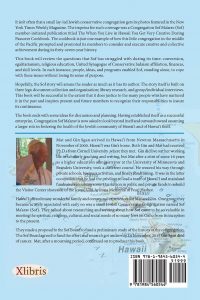
Honey and Poi – Sof Maʻarav History Books
Two books, courtesy of the Sof History Project. Honey and Poi provides a history of Sof Maʻarav from its founding in 1971 until today. The Sof Maʻarav History Project Appendix offers additional information and details gleaned from further research.
To purchase copies:
Book orders for Honey and Poi may be fulfilled at:
Web: Xlibris Online BookstoreOr by contacting Mathew Sgan
Hard cover book: $29.99, plus shipping & handling.
Soft cover book: $19.99, plus shipping & handling.
Ebook: $ 3.99
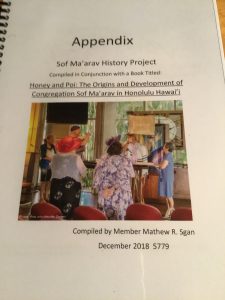
To purchase a copy of the Appendix, contact Mathew Sgan.
Appendix: $15.99, plus shipping and handling.
Updated Commentary
March 30, 2021
A recent article in the Tablet web magazine by Joel Kotkin and Edward Heyman is titled “The New American Judaism.” The authors review all the perils (millennial dropouts, intermarriage, low birth rates, Israel’s development) that threaten American Jewry. Using current surveys of American Jews, they go on to suggest that Chabad’s growth signifies one direction that American Jewry is taking. But for American Jews for whom Chabad is not the answer, Kotkin and Heyman present Kehilat Hadar (KH). KH is a 2001 enterprise of Rabbi Eli Kaunfer It is described as a prayer community with a traditional liturgy. It includes a Torah reading, commitment to full gender egalitarianism, services that don’t drag, and congregational engagement through music. The services are led by volunteers and KH has no paid clergy, KH values participation over membership and thrives on ‘network resilience.’ Sound familiar? C’est nous! One of the stimuli for Honey and Poi was to describe Congregation Sof Ma’arav as a kehillah that has blazed such a path successfully. Now some 50 years old and 20 years before KH, the foresight of Sof’s founders is manifest. Mazel Tov to the pioneers of Sof Ma’arav. Sof knew the answer even before surveys, Covid -19, and Zoom made the ongoing discussion about what Is good for American Jewry and how to keep it viable a front burner discussion.
Excerpts from the Preface to the Appendix of the Sof History Project
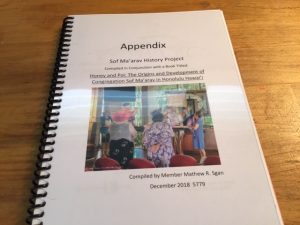
During the course of doing the research for the narrative (Honey and Poi) describing the origins and development of Congregation Sof Ma’arav, I was fortunate to be given a treasure chest of documents, photos, brochures, and newsletters. Such materials were of tremendous importance to recreating the history of Sof and telling its story. Through them and other sources, I was able to reconstruct lists of Bar/Bat Mitzvahs, office holders, shul finances, and events which added to the record.
While I was able to convey encapsulated reviews of such materials in moving the narrative forward, I felt an additional obligation to share them in some original form with all interested parties. They represent what is beyond the bare bones of the story and have a remarkable ability to transport readers back to being a member at the time the item was paramount.
The original incorporation papers and the names of the incorporators are examples of just who the Sof pioneers were and how they went about making sure that Sof had a firm foundation on which to build. Those papers are included as is a presentation of the actual exchanges during the egalitarian debate (role of women during services), which was a watershed moment in Sof history. That debate as recorded, invites readers to join in the discussion and to consider what their position would have been at that time. It also enables a person to bring a current perspective into the picture.
Organizing and displaying the materials was not best done, in my opinion, chronologically. Rather various topics presented themselves as being the most helpful for readers to follow and understand the nature of Sof during its 40 plus years. Certain topic titles (Communications; Community; Education) enabled me to classify items in an understandable way and to present them in the various forms that they assumed during Sof’s development. The narrative provided the story; the Appendix provided additional perspective and the backdrop of the story.
Honey and Poi – The Modern Years: 2000-2016
A New Century Brings Good News

As Sof headed into the turn of the century, good news predominated. The balance sheet, led by dues, donations and cookbook sales, indicated some $39,000 in income. This enabled Sof to purchase some needed service items (kitchen items, books, ritual products), keep up with operational and rent increases, and pay for outside leadership and associated costs for the 5760 High Holidays.
Even the USCJ (United Synagogue of Conservative Judaism) membership fee was paid without fuss! That had been an issue in prior years. A very positive sign of the times.
President Bernice Littman wrote, in her November 1999 message to the congregation, “5760 is proving to be another wonderful year.” She then went on to thank Ken Cohen for acting as cantor; Aileen Grill for her singing; Robert Littman and Bob Goldman for their talks; George Hudes, Sim Granoff, Marlene Booth and Jordan Popper for leading prayers; Robert Littman and Marv Black for organizing things; and Kat Tsuyemura with Francis Maltin, for managing food arrangements. Gregg Kinkley was applauded for his musical talent, prayer leadership and Torah/haftarot readings. Fran Margulies arranged for baby-sitting and Hinda Diamond collected food for the Hawaii Foodbank.
Bernice indicated that Sof’s reputation as the “party shul” was burnished with great Simchat Torah and Shabbat celebrations, along with Naomi Olstein’s anticipation of yet another lively Hanukkah get-together for latke making and candle lighting. Bernice claimed the “highest level” of member participation in Shabbat and holiday services. Ken Aronowitz and Hinda Diamond declared Sof’s Simchat Torah celebration the most spirited evening in the islands!Even the USCJ (United Synagogue of Conservative Judaism) membership fee was paid without fuss! That had been an issue in prior years. A very positive sign of the times.
President Bernice Littman wrote, in her November 1999 message to the congregation, “5760 is proving to be another wonderful year.” She then went on to thank Ken Cohen for acting as cantor; Aileen Grill for her singing; Robert Littman and Bob Goldman for their talks; George Hudes, Sim Granoff, Marlene Booth and Jordan Popper for leading prayers; Robert Littman and Marv Black for organizing things; and Kat Tsuyemura with Francis Maltin, for managing food arrangements. Gregg Kinkley was applauded for his musical talent, prayer leadership and Torah/haftarot readings. Fran Margulies arranged for baby-sitting and Hinda Diamond collected food for the Hawaii Foodbank.
Bernice indicated that Sof’s reputation as the “party shul” was burnished with great Simchat Torah and Shabbat celebrations, along with Naomi Olstein’s anticipation of yet another lively Hanukkah get-together for latke making and candle lighting. Bernice claimed the “highest level” of member participation in Shabbat and holiday services. Ken Aronowitz and Hinda Diamond declared Sof’s Simchat Torah celebration the most spirited evening in the islands!
Honey and Poi – The Middle Years: 1980-1999
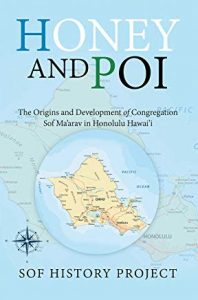
Background: In the beginning, Sof affiliated with the conservative movement of Judaism and was in touch with its headquarters at the Jewish Theological Seminary for ritual, religious, personnel, and organizational matters. The relationship had, however, not been smooth and questions of money payments and service rose often. In an effort to get back on a healthy relationship, Sof leaders initiated the following steps.
Relations between Sof and United Synagogue of America (now United Synagogue of Conservative Judaism) were once again brought up. President Merle Fischlowitz wrote to Rabbi Benjamin Kreitman, executive vice president of USAM, explaining Sof’s financial predicament and asking to be treated differently from other congregations because of its size, high cost of living, and geographical location. He suggested that the only regional service of which Sof had availed itself was Camp Ramah. Kreitman referred Fischlowitz’s letter to Harold Lipchik, chairman of the Economics Committee of the Pacific Southwest Region (PSWR), which handles the subject of Sof’s dues and relationships as a member of that region. Lipchik thanked Fischlowitz for his letter because the PWSR had been trying to establish contact with Sof for two years without success.
President Fischlowitz had proposed paying a sum of 6% of dues collected in 1985-86, a sum of 5% of dues collected in in 1986-87 plus 0.5% for Camp Ramah. Lipchik stated that Sof’s situation had always been recognized and that, on the basis of a new USAM plan officially beginning in 1987-88, payments to USAM would be based on a percentage of actual dues collected. Moreover, Lipchik was willing to begin this program in 1986-87, providing Sof forwarded 6% of its ’85-’86 dues collection, plus $500 to clear up the $2,737 in arrears at that point. Fischlowitz thanked Lipchik for his constructive letter and indicated that he would be back in touch after consulting with the Sof board. The financial arrangement (6% of collected dues plus $500) suggested in the letters between Merle Fishlowitz and Harold Lipchik of the PSWR of USAM was approved.
Update: Currently Sof pays about $1000 annually to USCJ. We receive a batch of Luachs (calendar of dates, rituals, aliyahs for services), listing on the USCJ website, publication and personnel information, and other support material from time to time.
Praise for Honey and Poi

Honey and Poi was published about 3 months ago, and the critical reviews of it have started to arrive. Here are a few samples:
- Perhaps the best book about a small conservative shul on an island in the Pacific thus far this year.
- Some may think of Leo Tolstoy’s War and Peace and Sholem Asch’s Tales of My People. Others may not think of those books.
- Almost Talmudic in its willingness to let everyone who’s anyone speak.
- You will not just read Honey and Poi; you will live it!
Shoshana and I are reading Honey and Poi to one another, and we are enjoying it immensely….What a wonderful contribution you have made both to Sof and to the understanding of Jewish life in Hawai’i. Yasher Koach!
– Rabbi Saul Perlmutter
Still, there are Sofers who have not yet joined in the fun of knowing who we are and how we came to be. Amazon, Xlibris, and Mat await your book and Appendix orders! Consider how happy your friends and family will be to receive these books. Joy unbounded! More information, contact Mat Sgan.
Honey and Poi – Author’s Preface

“I read Honey and Poi in one reading. I couldn’t put it down. I especially loved knowing the details of how the schul came into being, who the pioneers were, and the split involving egalitarianism. It is quite an accomplishment and a great service to our community.” – Gayle Goodman
This book has been a labor of love for me from the beginning. Congregation Sof Ma’arav from my perspective deserves all of the accolades which have been associated with it. I enjoyed writing about a group in which I have been an active participant.
For over four decades, Sof has been an educational center, a religious and spiritual guide, a support group, and an uplifting social setting for many who otherwise would have been without such life affirming associations. It has never turned its back on anyone responsive to and in need of the kind of program it had.
My research has included group and individual conversations, document review in the solitude of early morning page turning, and newspaper articles unfurled awkwardly on microfilm at the library. I was looking for information on the setting of Sof’s development, the people who made it happen, and the key factors of its ability to change without losing sight of the cultural vision of its founders.
In order to accommodate such aspiration, I wanted not only to produce this narrative, but also to provide a depository for Sof’s most important written and pictorial history. Hence, there is an accompanying Appendix which I hope readers will peruse. As my efforts increased, I came to see other aspects of this book. I hoped that it would be of interest to other Jewish people in Hawaii and elsewhere who might be responsive to becoming a more active part of their own heritage.
Perhaps, they would say that it was time to investigate what Judaism is really all about and how it will bring deeper meaning to their lives. Perhaps they will say that Sof Ma’arav or another Jewish organization is the kind of religious gathering that they would be pleased to join or initiate in their own community. I realize that is an elaborate hope for such a modest undertaking, but no one should underestimate the creativity of Jewish people.
From the Sof History Project
By Mat Sgan
 Newly elected president Peter Freeman (1991–1992) took a page out of Ronald Reagan’s playbook with a “Morning in Sof” optimistic approach. Beginning with a warm letter to fellow congregants, Freeman invited all to participate fully, and included a committee sign-up sheet. His new-day attitude extended to creating a summer/fall bulletin outlining exciting cooperation with Rabbi Leibowitz at AJC and TE president Steve Welid; organizing summer and weekly Shabbat services; publicizing Sof 1991–1992 officers and board members; and acknowledging a memorable Tisha B’Av service at AJC featuring a talk on Lamentations by Rabbi Jerome Epstein, CEO of USAM. Invitations were sent, especially to AJC and TE, but intended for the entire Jewish community of Oahu, to join Sof in celebrating Selichot (movie: Operation Solomon). Simchat Torah High Holiday services for 5752 were led by Jonathan Webber with commentary by “our scholar in residence,” Dr. Cyrus Gordon. Donors were sincerely thanked, and donations to the Torah fund were encouraged. An August 31 Havdalah followed by the Selichot service took place. Selichot was not only scheduled, it was explained. New Sof leyners added excitement and anticipation to Shabbat and festival services in 5752.
Newly elected president Peter Freeman (1991–1992) took a page out of Ronald Reagan’s playbook with a “Morning in Sof” optimistic approach. Beginning with a warm letter to fellow congregants, Freeman invited all to participate fully, and included a committee sign-up sheet. His new-day attitude extended to creating a summer/fall bulletin outlining exciting cooperation with Rabbi Leibowitz at AJC and TE president Steve Welid; organizing summer and weekly Shabbat services; publicizing Sof 1991–1992 officers and board members; and acknowledging a memorable Tisha B’Av service at AJC featuring a talk on Lamentations by Rabbi Jerome Epstein, CEO of USAM. Invitations were sent, especially to AJC and TE, but intended for the entire Jewish community of Oahu, to join Sof in celebrating Selichot (movie: Operation Solomon). Simchat Torah High Holiday services for 5752 were led by Jonathan Webber with commentary by “our scholar in residence,” Dr. Cyrus Gordon. Donors were sincerely thanked, and donations to the Torah fund were encouraged. An August 31 Havdalah followed by the Selichot service took place. Selichot was not only scheduled, it was explained. New Sof leyners added excitement and anticipation to Shabbat and festival services in 5752.
Sof History: Merle Fishlowitz
Oct 27, 2019
By Mat Sgan

We called former Sof President Merle Fishlowitz in doing research for our book Honey and Poi: The Origins and Development of Congregation Sof Ma’arav in Honolulu Hawaiʻi. He responded with deep conviction to questions about his relationship to Sof. After leaving Hawaiʻi, Merle felt so strongly about his Sof relationship that he donated the Torah that we use most often for Shabbat and Festival services.
From Honey and Poi
Two-term President Merle Fischlowitz (1986-1988) spoke highly about his Sof experience:
At Sof I learned about Jewish liturgy, prayer structure, and services. … I had never been aware of such matters, and knowing of them contributed to my education. … I learned by doing and by carefully listening to three or four very knowledgeable Sof members.
When asked about any feeling of disappointment about Sof, former President Fischlowitz remarked:
You have to make sure that there’s not a rotating, but a growing and changing leadership. … When people come in they should know that their contributions will be recognized and that they can become a part of the decision-making process.
Sof members are in luck. Mat has some hard covers ($29.99), soft covers ($19.99), and Appendices ($15.99) of Honey and Poi for you to purchase as gifts (New Year; Chanukah) for yourselves, your children, and grandchildren. They can learn more about the Jewish spirit. That spirit imbued a band of people committed to maintaining Judaism in their lives and the lives of their fellows with the energy and focus to establish Sof Ma’arav out of whole cloth. An amazing story about a lay-led boot strap shul associated with the structure and benefits of a synagogue, the love and support of family, and the learning of a graduate seminar.
Honey and Poi is also available at Amazon.
Frances Maltin’s Contribution to Major League Baseball
Contributed by Mat Sgan, part of the Sof Ma’arav History Project
As Mat Sgan explains:
Jackie Robinson broke the color line in Major League Baseball in 1947. Before that, and to prepare him and the world for that momentous occurrence, he played for the 1946 Triple A Montreal Royals baseball team. They were befriended by the Maltin family in Montreal.
Below is how Frances describes what happened:
When Jackie and his wife, Rachel, moved to Montreal, they did not live with us, but did become companions and lifelong friends. My father, Sam Maltin, who was a sports writer for the Montreal Herald at the time, is noted for writing this famous paragraph in baseball literary history.
“It was probably the only time that a black man ran away from a white mob with love instead of lynching on its mind.”
This was 1946, after Jackie led the Montreal Royals to the ‘little’ (AAA) World Series Championship. The crowd literally chased Jackie down the street in order to embrace him.
The PBS Jackie Robinson Story talked about how well the family fit into the Brooklyn neighborhood and showed a picture of Jackie and Rachel’s son, Jackie Jr. playing with a little white girl. Well, the picture was actually taken in Montreal and that little white girl is my younger sister.